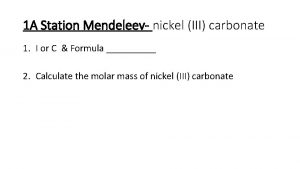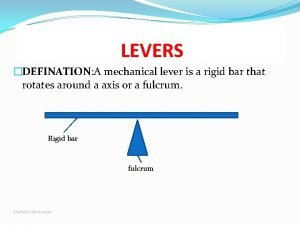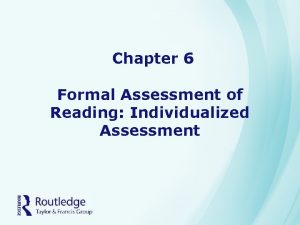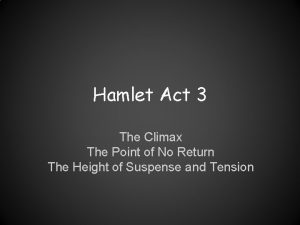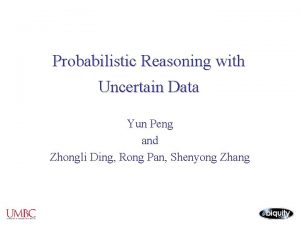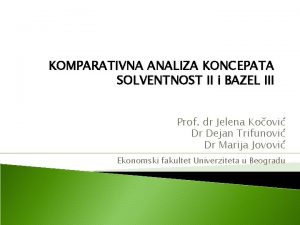Announcements Next homework assignment Homework III MP 23






































- Slides: 38

Announcements Next homework assignment: Homework III: MP 23. 4, MP 23. 12, MP 23. 19, MP 23. 34, MP 23. 38, MP 23. 62 and Hand-in (HI) 23. 41, 23. 59, 23. 64 Today: One final Gauss’ Law example, then start on electric potential.

Example Problem 2

Example Problem Initial charge density σ0=6. 37 x 10 -6 C/m 2 R 0 -q R 1 What is the initial total charge ? What is the surface charge density after the charge is introduced? 3

What is the E field outside the sphere ? R 0 -q R 1 What is the flux just inside the inner sphere ? 4

Electric Potential may have been invented by George Green 17931841), a rather obscure but brilliant English mathematician who lived in Nottingham. His work was later rediscovered by many great scientists. Also known for “Green’s Functions”.

Introduction • There is an energy associated with electric force: whenever we use electrical device it requires use of electrical energy. • If a charge is placed in electric field, the field will exert electric force on the charged particle and move it • the field does work on the particle • this work is done at the expense of ELECTRIC POTENTIAL ENERGY. • We will describe electric potential energy in terms of ELECTRIC POTENTIAL. • In circuits potential difference is called VOLTAGE (important for electric circuits, particle accelerators, electron beams, …) 6

PHYS 170 Question: What is the work done by a force as a particle moves from point a to point b ? N. B. This is a line integral Q: what is the work-energy theorem and how does it work for conservative forces ? Q: Do we care about the absolute value of U (potential energy) ? Ans: No, we care only about changes in U. But still must define a zero for potential energy ! N. B. subscripts and sgn here

Q: For a conservative force such as gravity or the electrical force, does the work done depend on the path from a to b ? Ans: No, it is independent of path for a conservative force. BTW what is an example of a non-conservative force ? Q: How does the change in potential energy relate to the change in kinetic energy for a conservative force ? Remember conservation of energy !

Some PHYSICS 170 (Mechanics) examples Two points to note: E= K+ U is constant. The absolute value of U is arbitrary, only differences in U have physical significance.

Electric Potential Energy in a Uniform Field In the figure, a pair of charged parallel metal plates sets up a uniform, downward electric field. The field exerts a downward force on a positive test charge. As the charge moves downward from point a to point b, the work done by the field is independent of the path the particle takes. Note the electric force is a conservative force

A Positive Charge Moving in a Uniform Field (1 of 2) If the positive charge moves in the direction of the field, the field does positive work on the charge. Hence the potential energy decreases.

A Positive Charge Moving in a Uniform Field (2 of 2) If the positive charge moves opposite the direction of the field, the field does negative work on the charge. The potential energy increases.

Electric Potential Energy of Two Point Charges (1 of 2) The work done by the electric field of one point charge on another does NOT depend on the path taken. Therefore, the electric potential energy only depends on the distance between the charges.

Electric Potential Energy of Two Point Charges (2 of 2) The electric potential energy of two point charges only depends on the distance between the charges. This equation is valid no matter what the signs of the charges are. Potential energy is defined to be zero when the charges are infinitely far apart. (but we could have picked another choice).

Electrical Potential with Several Point Charges The potential energy associated with q 0 depends on the other charges and their distances from q 0. The electric potential energy for multiple charges is the algebraic sum:

A positron (the electron’s antiparticle) has mass 9. 11× 10 -31 kg and charge q 0=+e=+1. 60× 10 -19 C. Suppose a positron moves in the vicinity of an α (alpha) particle, which has charge q=+2 e=3. 2× 10 -19 C and mass 6. 64× 10 -27 kg. The α particle’s mass is more than 7000 times that of the positron, so we assume that the α particle remains at rest. When the positron is 1. 0× 10 -10 m from the α particle, it is moving directly away from the α particle at 3. 0× 106 m/s. (a) What is the positron’s speed when the particles are 2. 0× 10 -10 m apart? (b) What is the positron’s speed when it is very far from the α particle? Q: How do we do energy conservation ? A: E= K + U should be constant. But what is U ? α Initial e+, r 0 Final e+, ra

Let’s apply this to our example.

Let’s apply this to our example. Q: How do we obtain the velocity ? Q: How does this change when the distance goes to infinity ? Ans: the Ub potential energy term goes to zero

Potential energy curves—PE versus r • Graphically, the potential energy between like charges increases sharply to positive (repulsive) values as the charges become close. • Unlike charges have potential energy becoming sharply negative as they become close (attractive). Depends on the boundary condition 19

Electric Potential (1 of 2) Electric Potential is potential energy per unit charge. The potential of a with respect to b (Vab = Va – Vb) equals the work done by the electric force when a unit charge moves from a to b.

Electric Potential The potential due to a single point charge is: Like electric field, the electric potential is independent of the test charge that we use to define it. For a collection of point charges:

Finding Electric Potential from the Electric Field If you move in the direction of the electric field, the electric potential decreases, but if you move opposite the field, the potential increases.

Electric Potential and Electric Field Moving with the direction of the electric field means moving in the direction of decreasing V, and vice versa. To move a unit charge slowly against the electric force, we must apply an external force per unit charge equal and opposite to the electric force per unit charge. The electric force per unit charge is the electric field. The potential difference Va – Vb equals the work done per unit charge by this external force to move a unit charge from b to a: The unit of electric field can be expressed as 1 N/C or 1 V/m N. B. Can also flip the sgn on the integral and interchange a&b

Potential difference (often called voltage in el. circuits) is a change of potential energy of charge-field system (i. e. q 1, q 0) when q 0 is moved from A to B, divided by q 0. Equipotential surfaces • In the case of 2 observation points, the potential difference is: We can only measure potential difference VB – VA ! 24

Special Clicker Question on the electric potential Consider a point P in space where the electric potential is zero. Which statement is correct? A. A positive point charge placed at point P would feel no electric force. B. A positive point charge placed at point P would feel an electric force, but nothing can be said about the direction of the force. C. A positive point charge placed near point P would feel an electric force pulling it toward P. D. A positive point charge placed near point P would feel an electric force pushing it away from P. E. More than one of the above is possible.

Special Clicker Question on the electric potential Consider a point P in space where the electric potential is zero. Which statement is correct? A. A positive point charge placed at point P would feel no electric force. B. A positive point charge placed at point P would feel an electric force, but nothing can be said about the direction of the force. C. A positive point charge placed near point P would feel an electric force pulling it toward P. D. A positive point charge placed near point P would feel an electric force pushing it away from P. E. More than one of the above is possible. Electric Potential differences are the key

Can we talk ? (about units) Joan Rivers

Q: What are the units of electrical potential energy U ? A: Joules or N-m Q: What are the units of electrical potential ? Ans: V (volts) If charge q equals the magnitude e of the electron charge, and the potential difference is 1 V, the change in energy is defined as one electron volt (e. V): Common units of energy are me. V, ke. V, Ge. V, Te. V Important: the electron mass is 511 ke. V/c 2 and the proton mass is 938 Me. V/c 2

Electron Volts and Cancer Radiotherapy One way to destroy a cancerous tumor is to aim high-energy electrons directly at it. Each electron has a kinetic energy of 4 to 20 Me. V (1 Me. V = 106 e. V), and transfers its energy to the tumor through collisions with the tumor’s atoms. Electrons in this energy range can penetrate only a few centimeters into a patient, which makes them useful for treating superficial tumors, such as those on the skin or lips.

Ionization and Corona Discharge At an electric-field magnitude of about 3 x 106 V/m or greater, air molecules become ionized, and air becomes a conductor. For a charged conducting sphere, Vsurface = Esurface R. Thus, if Em is the electric-field magnitude at which air becomes conductive (known as the dielectric strength of air), then the maximum potential Vm to which a spherical conductor can be raised is Vm = REm.

Example Problem on electric potential Two point charges q 1 = +2. 4 n. C and q 2 = -6. 5 n. C are 0. 1 m apart. Point A is midway between them; point B is 0. 08 m from q 1 and 0. 06 m from q 2. Take the electric potential to be zero at infinity. Find: A) the potential at point A B) the potential at point B 31

Example Problem 23. 19. 32

Clicker Question 1 If I walk out of this room, walk up the stairs to my office, say hello to my neighbor, take the elevator back downstairs and return to the podium - What is my change in potential energy? A. Decreased B. Increased C. Unchanged 33

Clicker Question 1 - Answer If I walk out of this room, walk up the stairs to my office, say hello to my neighbor, take the elevator back downstairs and return to the podium - What is my change in potential energy? A. Decreased B. Increased C. Unchanged 34

Clicker Question 2 When a negative charge moves in the direction of the electric field, A. the field does positive work on it and the potential energy increases. B. the field does positive work on it and the potential energy decreases. C. the field does negative work on it and the potential energy increases. –q Motion D. the field does negative work on it and the potential energy decreases. 35

Clicker Question 2 - Answer When a negative charge moves in the direction of the electric field, A. the field does positive work on it and the potential energy increases. B. the field does positive work on it and the potential energy decreases. C. the field does negative work on it and the potential energy increases. –q Motion D. the field does negative work on it and the potential energy decreases. 36

Clicker Question 3 We have 2 car batteries (12 V), one of which has its + (positive) terminal connected to ground and the other its – (negative) terminal grounded. The other 2 terminals are left disconnected. If we measure the voltage between the 2 disconnected terminals, what is the voltage? A. 0 V B. 12 V C. 24 V D. Sqrt(2)*12 V 37

Clicker Question 3 - Answer We have 2 car batteries (12 V), one of which has its + (positive) terminal connected to ground and the other its – (negative) terminal grounded. The other 2 terminals are left disconnected. If we measure the voltage between the 2 disconnected terminals, what is the voltage? A. 0 V B. 12 V C. 24 V D. Sqrt(2)*12 V 38
 X.next = x.next.next
X.next = x.next.next Kayl announcements
Kayl announcements /r/announcements
/r/announcements General announcements
General announcements David ritthaler
David ritthaler Fahrenheit 451 burning
Fahrenheit 451 burning Pvu market cap
Pvu market cap Hamlet act iii scene iii
Hamlet act iii scene iii Weekly homework assignment sheet
Weekly homework assignment sheet Flow diagram homework assignment
Flow diagram homework assignment Jack prelutsky homework oh homework
Jack prelutsky homework oh homework Homework oh homework poem
Homework oh homework poem Jack prelutsky homework oh homework
Jack prelutsky homework oh homework Grant always turns in his homework
Grant always turns in his homework Homework oh homework i hate you you stink
Homework oh homework i hate you you stink Homework oh homework i hate you you stink
Homework oh homework i hate you you stink Type 3 nomenclature
Type 3 nomenclature Intelligaire iii
Intelligaire iii Nickel(iii) carbonate
Nickel(iii) carbonate Referens iii
Referens iii Examples of lever
Examples of lever Dips iii
Dips iii Fat sholes
Fat sholes Auribus tenere lupum
Auribus tenere lupum Julius caesar exposition
Julius caesar exposition Vector iii
Vector iii Triamminetriaquachromium(iii)
Triamminetriaquachromium(iii) Perintah am bab b elaun lebih masa
Perintah am bab b elaun lebih masa Wiat iii
Wiat iii Hamlet act 3, scene 1
Hamlet act 3, scene 1 What is a class iii laser
What is a class iii laser Ipfp phase iii
Ipfp phase iii The byzantine empire and emerging europe
The byzantine empire and emerging europe Richard iii pursuit of power
Richard iii pursuit of power Obie ford iii
Obie ford iii Nic iii
Nic iii Bsid-iii-nl
Bsid-iii-nl Exercícios present perfect 9 ano com gabarito doc
Exercícios present perfect 9 ano com gabarito doc Bazel iii
Bazel iii


















